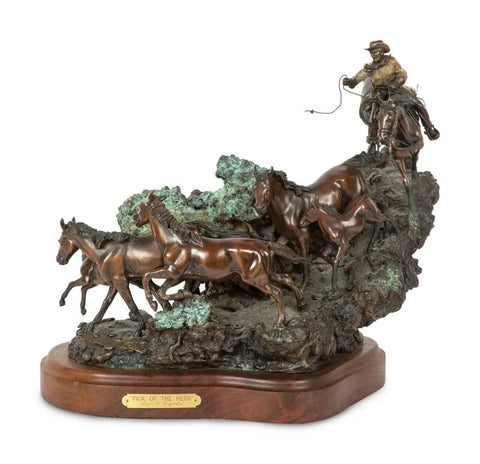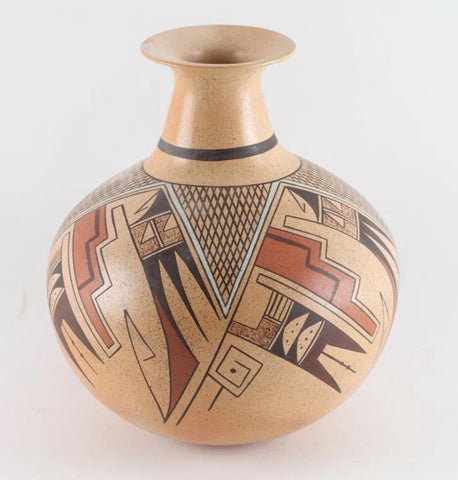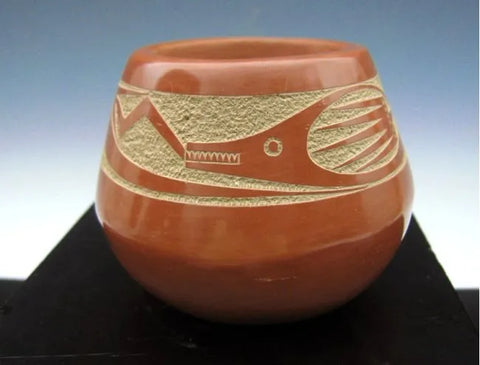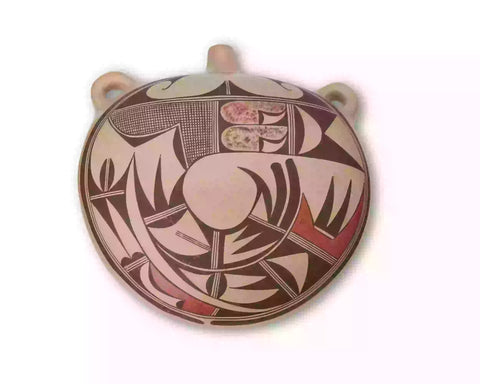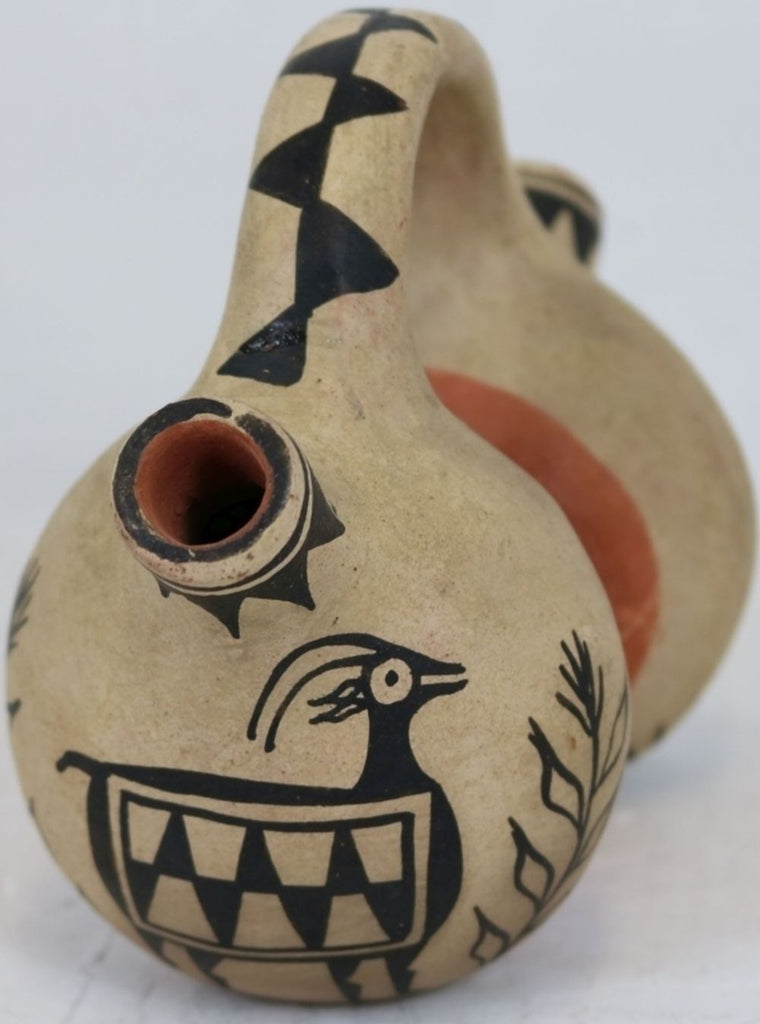
Native American, Santa Domingo Double Pottery Poly Chrome Canteen, by Robert Tenorio, Ca,. 1970's-80's, #1451 SOLD
$ 1,500.00
Native American, Santa Domingo Double Pottery Poly Chrome Canteen, by Robert Tenorio, Ca,. 1970's-80's, #1451
Description: #1451 Native American, Santa Domingo Double Poly Chrome Pottery Canteen, by Robert Tenorio, Ca,. 1970's-80's. Unusual Robert Tenorio double pottery canteen, by Robert Tenorio. Strange barbell shape, pots are connected, a handle attaches the two. Robert Tenorio (b.1950- ) of Santo Domingo (Kewa Pueblo) is one of the foremost Pueblo potters working today and has played an extremely important role in reviving and bringing attention to the legacy of Santo Domingo pottery. He first learned the fundamentals of working with clay at the age of ten from family members, including his grandmother Andrea Ortiz. As he learned he began collecting native clay's and experimenting with the traditional firing methods of his ancestors. Date: Location: Santo Domingo Pueblo, New Mexico.
Dimensions: each pot is 5"; diameter, and 7.25"; high
Condition: Very good for its age. Some flea bits around one of the canteen lips.
Robert Tenorio was born in 1950 into the Santo Domingo “Kewa” Pueblo. He has been working with clay since the age of 10. He was taught all the fundamentals of hand coiling pottery using ancient traditional methods from his family members. Lupe Tenorio shared some of her special techniques with Robert. He was also inspired to continue the long lived family tradition from the admiration he had for old pottery from his village.
Robert is one of the foremost pueblo potters. He wins ribbons regularly at Santa Fe Indian Market and other prestigious competitions. His work is among the most traditional of any potters working today. All of his pieces are hand coiled and fired outdoors with cottonwood bark. He is especially well known for creating some of the largest pieces produced by any pueblo potter.
Robert began his career by studying jewelry making. In 1968, he enrolled at the Institute of American Indian Arts in Santa Fe. Learning to make jewelry "was the popular thing then," he recalls, plus "I wanted to make jewelry to help with the family." Robert, however, soon found himself next door in the ceramics class, "stealing their clay and potting away"
Robert began by making stew bowls for his mother. When other women at the Pueblo saw them, they wanted bowls too and so Robert's mother was constantly at the school asking him to make more bowls.
In those days, Robert's bowls were made from stoneware, a type of processed clay that is fired in a kiln. Today, Robert uses native clays and traditional firing methods.
The black on Robert's pottery usually comes from the Rocky Mountain bee plant. "We boil the whole plant," he says, however he has discovered that boiling almost any kind of plant will produce a black juice. Robert prefers the bee plant because in the old days "it was our people's food, and it's still present in our food. We call it wild spinach."
In thinking about his distinguished career, Robert observes: "I don't ever want to become too famous or too rich. We're all striving for life, and pottery is bringing me and my family life. I feel I was put in this world to revive Santo Domingo pottery. And now that I've done that, I feel good about it. I'm content. Everybody living will go, but my pots will stay here on this earth forever."
He signs his pottery as: Robert Tenorio, followed by small dipper star formation, and Kewa. He is related to: Paulita Pacheco (sister), Gilbert Pacheco (brother-in-law), Hilda Coriz (sister), Ione Coriz (niece), and Juanita Tenorio (mother).
Awards:
-Santa Fe Indian Market 1st Place
-Eighth Northern Arts & Crafts Show 1st Place
Publications:
-Southern Pueblo Pottery 2,000 Artist Biographies
-Talking With the Clay
-Collections of Southwestern Pottery
-Southwestern Pottery Anasazi to Zuni
-Fourteen Families in Pueblo Pottery
-American Indian Pottery 2nd Edition
(Source: ancientnations.com)
-----------
A History of Pueblo Pottery:
“Pueblo pottery is made using a coiled technique that came into northern Arizona and New Mexico from the south, some 1500 years ago. In the four-corners region of the US, nineteen pueblos and villages have historically produced pottery. Although each of these pueblos use similar traditional methods of coiling, shaping, finishing and firing, the pottery from each is distinctive.
Various clay's gathered from each pueblo’s local sources produce pottery colors that range from buff to earthy yellows, oranges, and reds, as well as black. Fired pots are sometimes left plain and other times decorated—most frequently with paint and occasionally with appliqué. Painted designs vary from pueblo to pueblo, yet share an ancient iconography based on abstract representations of clouds, rain, feathers, birds, plants, animals and other natural world features.
Tempering materials and paints, also from natural sources, contribute further to the distinctiveness of each pueblo’s pottery. Some paints are derived from plants, others from minerals. Before firing, potters in some pueblos apply a light colored slip to their pottery, which creates a bright background for painted designs or simply a lighter color plain ware vessel. Designs are painted on before firing, traditionally with a brush fashioned from yucca fiber.
Different combinations of paint color, clay color, and slips are characteristic of different pueblos. Among them are black on cream, black on buff, black on red, dark brown and dark red on white (as found in Zuni pottery), matte red on red, and polychrome—a number of natural colors on one vessel (most typically associated with Hopi). Pueblo potters also produce undecorated polished black ware, black on black ware, and carved red and carved black wares.
Making pueblo pottery is a time-consuming effort that includes gathering and preparing the clay, building and shaping the coiled pot, gathering plants to make the colored dyes, constructing yucca brushes, and, often, making a clay slip. While some Pueblo artists fire in kilns, most still fire in the traditional way in an outside fire pit, covering their vessels with large potsherds and dried sheep dung. Pottery is left to bake for many hours, producing a high-fired result.
Today, Pueblo potters continue to honor this centuries-old tradition of hand-coiled pottery production, yet value the need for contemporary artistic expression as well. They continue to improve their style, methods and designs, often combining traditional and contemporary techniques to create striking new works of art.” (Source: Museum of Northern Arizona)
----------
View the other items in my shop: http://www.etsy.com/shop/CulturalPatina?ref=shopsection_shophome_leftnav
Description: #1451 Native American, Santa Domingo Double Poly Chrome Pottery Canteen, by Robert Tenorio, Ca,. 1970's-80's. Unusual Robert Tenorio double pottery canteen, by Robert Tenorio. Strange barbell shape, pots are connected, a handle attaches the two. Robert Tenorio (b.1950- ) of Santo Domingo (Kewa Pueblo) is one of the foremost Pueblo potters working today and has played an extremely important role in reviving and bringing attention to the legacy of Santo Domingo pottery. He first learned the fundamentals of working with clay at the age of ten from family members, including his grandmother Andrea Ortiz. As he learned he began collecting native clay's and experimenting with the traditional firing methods of his ancestors. Date: Location: Santo Domingo Pueblo, New Mexico.
Dimensions: each pot is 5"; diameter, and 7.25"; high
Condition: Very good for its age. Some flea bits around one of the canteen lips.
Robert Tenorio was born in 1950 into the Santo Domingo “Kewa” Pueblo. He has been working with clay since the age of 10. He was taught all the fundamentals of hand coiling pottery using ancient traditional methods from his family members. Lupe Tenorio shared some of her special techniques with Robert. He was also inspired to continue the long lived family tradition from the admiration he had for old pottery from his village.
Robert is one of the foremost pueblo potters. He wins ribbons regularly at Santa Fe Indian Market and other prestigious competitions. His work is among the most traditional of any potters working today. All of his pieces are hand coiled and fired outdoors with cottonwood bark. He is especially well known for creating some of the largest pieces produced by any pueblo potter.
Robert began his career by studying jewelry making. In 1968, he enrolled at the Institute of American Indian Arts in Santa Fe. Learning to make jewelry "was the popular thing then," he recalls, plus "I wanted to make jewelry to help with the family." Robert, however, soon found himself next door in the ceramics class, "stealing their clay and potting away"
Robert began by making stew bowls for his mother. When other women at the Pueblo saw them, they wanted bowls too and so Robert's mother was constantly at the school asking him to make more bowls.
In those days, Robert's bowls were made from stoneware, a type of processed clay that is fired in a kiln. Today, Robert uses native clays and traditional firing methods.
The black on Robert's pottery usually comes from the Rocky Mountain bee plant. "We boil the whole plant," he says, however he has discovered that boiling almost any kind of plant will produce a black juice. Robert prefers the bee plant because in the old days "it was our people's food, and it's still present in our food. We call it wild spinach."
In thinking about his distinguished career, Robert observes: "I don't ever want to become too famous or too rich. We're all striving for life, and pottery is bringing me and my family life. I feel I was put in this world to revive Santo Domingo pottery. And now that I've done that, I feel good about it. I'm content. Everybody living will go, but my pots will stay here on this earth forever."
He signs his pottery as: Robert Tenorio, followed by small dipper star formation, and Kewa. He is related to: Paulita Pacheco (sister), Gilbert Pacheco (brother-in-law), Hilda Coriz (sister), Ione Coriz (niece), and Juanita Tenorio (mother).
Awards:
-Santa Fe Indian Market 1st Place
-Eighth Northern Arts & Crafts Show 1st Place
Publications:
-Southern Pueblo Pottery 2,000 Artist Biographies
-Talking With the Clay
-Collections of Southwestern Pottery
-Southwestern Pottery Anasazi to Zuni
-Fourteen Families in Pueblo Pottery
-American Indian Pottery 2nd Edition
(Source: ancientnations.com)
-----------
A History of Pueblo Pottery:
“Pueblo pottery is made using a coiled technique that came into northern Arizona and New Mexico from the south, some 1500 years ago. In the four-corners region of the US, nineteen pueblos and villages have historically produced pottery. Although each of these pueblos use similar traditional methods of coiling, shaping, finishing and firing, the pottery from each is distinctive.
Various clay's gathered from each pueblo’s local sources produce pottery colors that range from buff to earthy yellows, oranges, and reds, as well as black. Fired pots are sometimes left plain and other times decorated—most frequently with paint and occasionally with appliqué. Painted designs vary from pueblo to pueblo, yet share an ancient iconography based on abstract representations of clouds, rain, feathers, birds, plants, animals and other natural world features.
Tempering materials and paints, also from natural sources, contribute further to the distinctiveness of each pueblo’s pottery. Some paints are derived from plants, others from minerals. Before firing, potters in some pueblos apply a light colored slip to their pottery, which creates a bright background for painted designs or simply a lighter color plain ware vessel. Designs are painted on before firing, traditionally with a brush fashioned from yucca fiber.
Different combinations of paint color, clay color, and slips are characteristic of different pueblos. Among them are black on cream, black on buff, black on red, dark brown and dark red on white (as found in Zuni pottery), matte red on red, and polychrome—a number of natural colors on one vessel (most typically associated with Hopi). Pueblo potters also produce undecorated polished black ware, black on black ware, and carved red and carved black wares.
Making pueblo pottery is a time-consuming effort that includes gathering and preparing the clay, building and shaping the coiled pot, gathering plants to make the colored dyes, constructing yucca brushes, and, often, making a clay slip. While some Pueblo artists fire in kilns, most still fire in the traditional way in an outside fire pit, covering their vessels with large potsherds and dried sheep dung. Pottery is left to bake for many hours, producing a high-fired result.
Today, Pueblo potters continue to honor this centuries-old tradition of hand-coiled pottery production, yet value the need for contemporary artistic expression as well. They continue to improve their style, methods and designs, often combining traditional and contemporary techniques to create striking new works of art.” (Source: Museum of Northern Arizona)
----------
View the other items in my shop: http://www.etsy.com/shop/CulturalPatina?ref=shopsection_shophome_leftnav
Related Products
Sold out
Sold out





